Physical Address
304 North Cardinal St.
Dorchester Center, MA 02124
The ear, and particularly the earlobe, plays a significant role in appearance, and has traditionally been adorned with earrings.
The auricle consists of skin and cartilage, whereas the earlobe consists of skin and fibrous fatty tissue and is devoid of cartilage. The earlobe is easily split as a result of the weight of earrings.
The ears and the earlobes are prone to the formation of hypertrophic scars and keloids, particularly in susceptible populations.
Different techniques are available for the repair of split earlobes, with or without preservation of the earring canal. The choice of technique depends upon the nature of the split (whether full or partial) and whether the canal is to be preserved.
Ears can be pierced using a one-needle or a two-needle technique; commercial kits are available.
Drooping earlobes can be congenital or caused by aging, gravity, and disease. They may be reduced by several surgical techniques.
Split earlobes and enlarged pierced earlobe canals are common problems that may have a congenital or traumatic cause. Traumatic causes of split earlobes include sudden pulling of an earring, wearing heavy earrings, pressure necrosis caused by clip-on earrings, the weight of a telephone receiver on an earring, infection, an allergic reaction, multiple piercings, and a piercing site too low in the earlobe. The partially split earlobe usually occurs following ear piercing and the wearing of heavy earrings ( Fig. 48.1 ). The completely split earlobe usually results from the gradual downward progression of the partially split earlobe, or from a sudden trauma ( Fig. 48.2 ). Several repair options have been described to restore these defects.
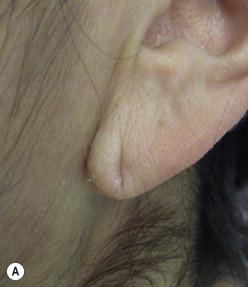
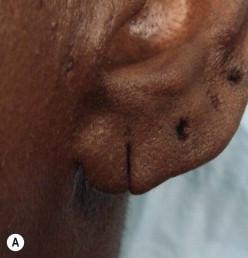
Patient evaluation should include taking a history of hypertrophic scars or keloids. Enquiries should be made about the patient's expectations of the cosmetic outcome, and whether there will be a continuing desire to wear earrings. Antiseptic cleansing is required on both sides of the split earlobe before the procedure is begun.
A general dermatologic surgery tray is prepared with a no.15 surgical blade, a chalazion clamp (which stabilizes the split earlobe and provides hemostasis), or sterile wooden tongue depressor (if a chalazion clamp is not available), and local anesthesia is then applied to the split earlobe until it becomes firm and pale; this is achieved by lidocaine injection with a 30-gauge needle. Non-absorbable 5-0 or 6-0 suture or surgical plain gut suture is used for cutaneous closure. Absorbable 5-0 or 6-0 suture may be required for subcutaneous closure.
This technique is illustrated in Figures 48.3 and 48.4 . The split earlobe is stabilized with a chalazion clamp during the cutting. Both sides of the epithelialized skin of the split are excised with narrow margins anteriorly and posteriorly with a no.15 surgical blade. Care is taken to avoid cross-hatching of the excision at the ends of the split, or excising unequal length of the split edges, which will result in a dog-ear deformity. The resulting defect is closed with simple side-to-side interrupted sutures on both the anterior and posterior surface of the earlobe. Absorbable 5-0 or 6-0 subcutaneous suture may also be used but is not necessary. (See ![]() .)
.)
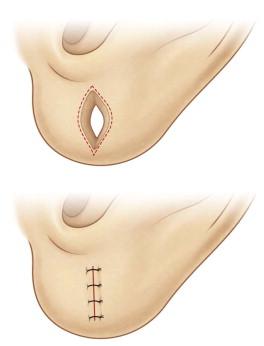
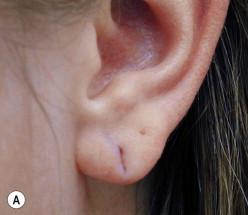
The punch technique ( Fig. 48.5 ) is a variant of this for enlarged round pierced canals of <4 mm in diameter. The epithelium-lined edges of these pierced canals are excised by a punch while the earlobe is stabilized with a chalazion clamp. The resulting round defect is closed as noted above. This technique is not recommended for a split larger than 4 mm in diameter because dog-ear deformities arise upon suturing. The suture line may be vertical or horizontal depending on the shape of the ear, but the horizontal line may be more supportive of the earring load in the future.
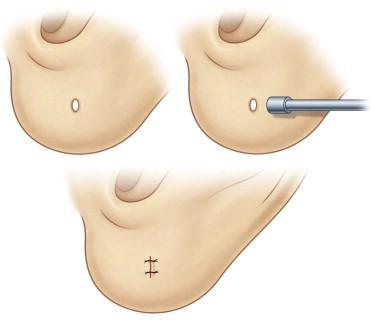
Two opposing flaps are created on the anterior and posterior surface of the earlobe. Each flap is based alternately on the medial edge or the lateral edge of the split. The flaps are pulled through the split and attached to the freshened surface on the opposite side, which resulted from the creation of the other flap ( Fig. 48.6 ). The use of “purse-string” technique following a full-thickness elliptical excision in the repair of a partially split earlobe has been reported.
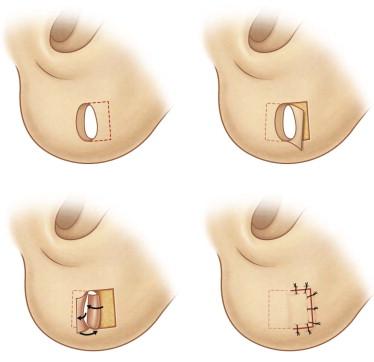
Completely split earlobes are more difficult to repair, as there is a loss of the inferior margin of the earlobe. Notching at the inferior rim of the earlobe may occur after repair. The indentation occurs from scar contraction and it can be prevented by several techniques, such as vertical mattress sutures, Z-plasty, L-plasty, V-flap, and lap-joint. The canals for earrings may be left in place by not excising the skin edges of the superior portion of the split, or may be constructed simultaneously with the repair of the split using a superiorly based skin flap. Some prefer to make the repair without preservation of the pierced canals; if desired, ear piercing may be performed 6–8 weeks later.
All techniques described below begin with careful planning followed by a critical excision of the slit in the lobule to obtain the desired results. The split earlobe is stabilized with a chalazion clamp during the excision. Both sides of the epithelialized skin of the split are excised with narrow margins anteriorly and posteriorly with a no.15 surgical blade. Care is taken to avoid cross-hatching of the excision at the superior end of the split, or excising unequal length of the split edges. (See ![]() .)
.)
The completely split earlobe can be repaired with a side-to-side closure. Vertical or horizontal mattress sutures are placed on the inferior rim of the earlobe to create wound eversion and reduce the risk of notching. Simple interrupted or mattress sutures may be used for the rest of the surgical line ( Fig. 48.7 ). Undermining the wound edges 1 mm prior to approximation to maximize wound eversion can be useful.
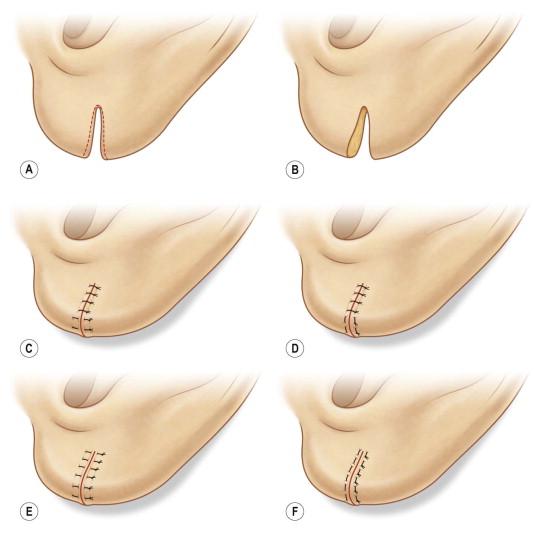
A small Z-plasty of the earlobe at the inferior pole of the repair may diminish scar formation and contraction, further reducing the risk of notching ( Fig. 48.8 ). Z-plasty may be used on the anterior skin of the earlobe and a vertical linear closure on the posterior surface if this helps attain the desired lobule configuration. The Z-plasty may be widened to an L-plasty, and can be performed with or without reconstruction of the pierced canal in a similar way and closed with simple interrupted sutures. If a canal is desired, a small flap at the superior end of the split is preserved and turned over and stitched on the anterior and posterior aspects. Both Z-plasty and L-plasty repairs prevent notching at the inferior border of the earlobe because the line of scar contracture is broken up. Enlarging the arms of the L-plasty ( Fig. 48.9 ) creates a triangular flap on the anterior surface of one edge. The posterior surface of the other edge is cut in the same way with a similar amount of tissue excised. The resulting triangular flaps overlap. Sutures are placed on the anterior and posterior sides with the consequent Z-suture line at the inferior rim of the earlobe. This technique also staggers the scar on the free border of the earlobe to avoid notching.
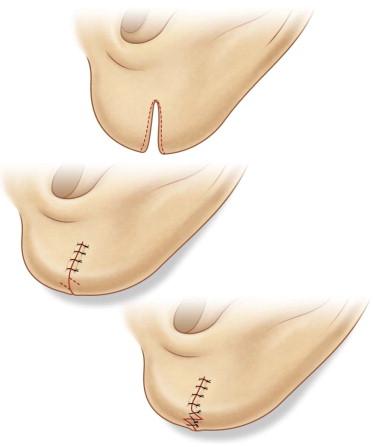
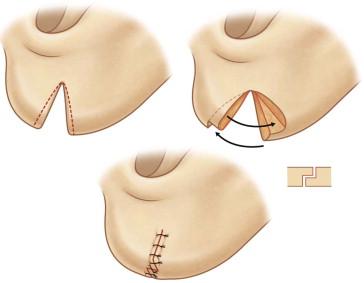
A single layer side-to-side closure with Z-plasty at the inferior margin of the earlobe ( Fig. 48.8 ) allows redirection of the vector of the wound contraction to decrease the risk of notching. Tip stitches are not required because the tips of the flaps are very small. The scar line of the Z-plasty is concealed within the inferior rim of the earlobe and stitched with simple interrupted sutures. If a canal is desired, a small flap as described above can be created.
Two V-flap variants may be of use. In one, a 3-mm V-shaped socket is cut from the fat on one side of the split earlobe. On the other side of the split earlobe, an inverted V-shaped joint is cut into the fat to receive the opposite side. The flaps are stitched with simple interrupted sutures ( Fig. 48.10 ). An alternative to this is the partially incised V-plasty which augments the earlobe's thickness as two de-epithelialized triangular areas are defined along the edges of the split. The base of the triangle is placed on the inferior rim of the earlobe and its apex pointed to the superior part of the split. These two triangular areas are de-epithelialized and the raw areas are moved to overlap each other, resulting in an increased thickness of the earlobe. The suture lines are placed on the anterior and posterior surface and they run obliquely rather than overlap each other ( Fig. 48.11 ).

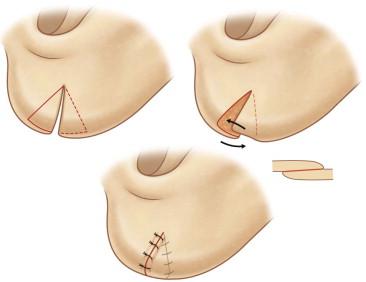
Rotational flaps can be used if the lower border and the lateral edge of the lateral part of the split are excised to distances that will fit a rotational flap from the medial part of the split ( Fig. 48.12 ).
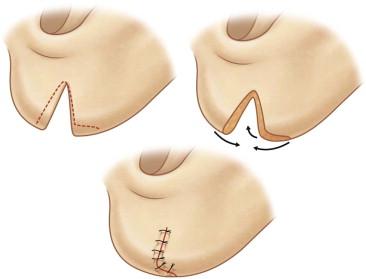
There are several techniques to repair the split earlobe with preservation of the pierced canal – for example, the skin edges can be joined below the pierced canal, or a flap can be used to create an epithelialized canal. These techniques may be used in the repair of partially split earlobes if desired. Earrings, or a non-absorbable material such as 1-0 or 2-0 nylon sutures, are used to maintain the newly formed canal.
Preservation of skin at apex of the split earlobe allows the split to be preserved with a side-to-side closure similar to that shown in Figure 48.7 , except that the untraumatized upper pole of the canal is left in situ.
Creation of a flap from a lateral portion of a split lobe uses skin at the upper end of one side of the split to form a flap ( Fig. 48.13 ) whose superiorly based skin is trimmed to the appropriate length, turned, and sutured to the opposite side of the split to form a pierced canal. A suture-free floor of the newly formed canal minimizes the risk of split recurrence. This can be combined with a Z-plasty as described above to prevent notching. Many variations on these techniques have been described.
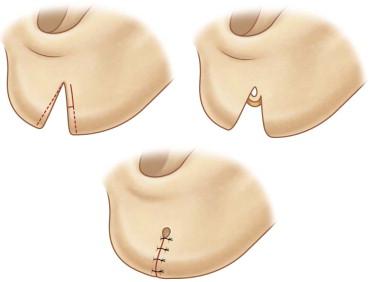
Modifications to optimize outcomes include avoiding cross-hatching of the inverted “V” excision at the superior end of the complete split and at both ends of the partial splits. “Dog-ear” removal at the apex of the split compensates for the length differences. When a partial split is nearly complete and the excision of epithelialized tract at the inferior border is difficult, the tissue at the inferior margin of the split may be discarded and the repair carried out as for a completely split earlobe. Completely split earlobes tend to have unequal lengths at the medial and lateral edges. Attention should be given to placing the first stitch inferiorly in order to restore the convexity of the inferior rim. Thicker earlobes may require one or two dermal sutures, which should be carefully placed to avoid a length discrepancy between the medial and lateral edges of the split. If re-piercing is considered, it should be delayed at least 6 weeks, though a pierced canal that allows the weight of the earring to be carried directly on the repair scar may result in a recurrence of the split. The re-pierced site should not be placed directly over the repair scar line. Wearing heavy earrings should be avoided.
Regular daily wound care is advised and suture removal is performed 7–14 days after the procedure.
The potential complications of split earlobe repair include bleeding, infection, notching of the earlobes, hypertrophic scars, and keloids. Methods to manage these complications are summarized below.
Bleeding is managed by external compression.
Infection requires antibiotics and wound care.
Notching of earlobes can occur and will require scar revision.
Hypertrophic scars can be treated with intralesional corticosteroids, silicone gel sheeting, cryotherapy, or laser therapy.
Keloids (see Chapter 43 ) require combination therapy, including some or all of the following: surgical excision, intralesional corticosteroids, intralesional interferon, intralesional 5-fluorouracil, silicone gel sheeting, cryotherapy, and laser therapy.
Become a Clinical Tree membership for Full access and enjoy Unlimited articles
If you are a member. Log in here